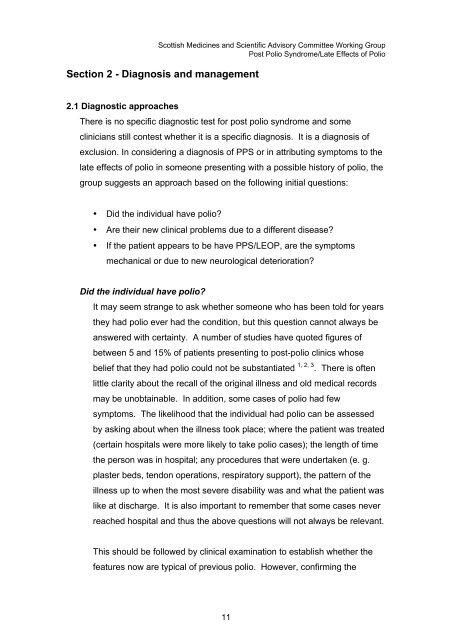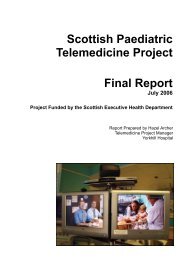SMASAC Working Group Post Polio Syndrome - Scottish Health On ...
SMASAC Working Group Post Polio Syndrome - Scottish Health On ...
SMASAC Working Group Post Polio Syndrome - Scottish Health On ...
Create successful ePaper yourself
Turn your PDF publications into a flip-book with our unique Google optimized e-Paper software.
<strong>Scottish</strong> Medicines and Scientific Advisory Committee <strong>Working</strong> <strong>Group</strong><br />
<strong>Post</strong> <strong>Polio</strong> <strong>Syndrome</strong>/Late Effects of <strong>Polio</strong><br />
Section 2 - Diagnosis and management<br />
2.1 Diagnostic approaches<br />
There is no specific diagnostic test for post polio syndrome and some<br />
clinicians still contest whether it is a specific diagnosis. It is a diagnosis of<br />
exclusion. In considering a diagnosis of PPS or in attributing symptoms to the<br />
late effects of polio in someone presenting with a possible history of polio, the<br />
group suggests an approach based on the following initial questions:<br />
• Did the individual have polio?<br />
• Are their new clinical problems due to a different disease?<br />
• If the patient appears to be have PPS/LEOP, are the symptoms<br />
mechanical or due to new neurological deterioration?<br />
Did the individual have polio?<br />
It may seem strange to ask whether someone who has been told for years<br />
they had polio ever had the condition, but this question cannot always be<br />
answered with certainty. A number of studies have quoted figures of<br />
between 5 and 15% of patients presenting to post-polio clinics whose<br />
belief that they had polio could not be substantiated 1, 2, 3 . There is often<br />
little clarity about the recall of the original illness and old medical records<br />
may be unobtainable. In addition, some cases of polio had few<br />
symptoms. The likelihood that the individual had polio can be assessed<br />
by asking about when the illness took place; where the patient was treated<br />
(certain hospitals were more likely to take polio cases); the length of time<br />
the person was in hospital; any procedures that were undertaken (e. g.<br />
plaster beds, tendon operations, respiratory support), the pattern of the<br />
illness up to when the most severe disability was and what the patient was<br />
like at discharge. It is also important to remember that some cases never<br />
reached hospital and thus the above questions will not always be relevant.<br />
This should be followed by clinical examination to establish whether the<br />
features now are typical of previous polio. However, confirming the<br />
11



